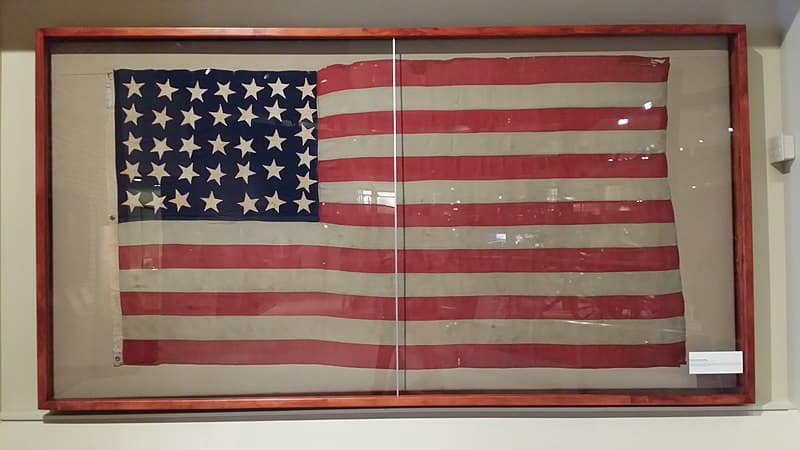The American flag has been through quite a few changes over the years. Each iteration of the flag had intention behind it, leading us to the flag that is currently in use today. In 1865, a transition would take place that would slightly edit the American flag, bringing it slightly closer to what we see flying in modern years. Let’s take a look at the 1865 American flag and learn about its history, meaning, and symbolism.
The 1865 American Flag — A Transitional Period
The modern “bones” of the flag of the United States have been in use since 1777, when the thirteen-star flag was first introduced. This famous design featured the thirteen stars on a blue field, plus the red and white stripes we all recognize. Every few years, however, that design was modified slightly.
The Flag of 1863-1865
The American flag iteration known as the “35-Star Flag” was used between 1863 and 1865 after it became official on July 4th, 1863. The flag was slightly changed from the previous flag to add an additional star in order to represent a new state being added to the Union: West Virginia. Since West Virginia was officially founded on June 20, 1863, the stars on the flag needed to be updated. The flag would last for two years until another state was to be added to the Union.
While the thirty-five-star flag iteration was around, two presidents served under it: Abraham Lincoln and Andrew Johnson. Lincoln served as President from 1861 to 1865, and Johnson served as president from 1865 to 1869. Both presidents played important roles in the history of the United States, with Lincoln leading the country through the Civil War and Johnson overseeing the Reconstruction era following the war.

©GreenMeansGo, CC BY-SA 4.0 <https://ift.tt/xp8Z2Pb>, via Wikimedia Commons – License
The Flag of 1865-1867
In a similar fashion to the first, the existing flag needed to be updated to reflect another state being added to the Union. This time, the state being added was Nevada, bringing the total number of states up to thirty-six. The resulting flag, the thirty-six-star flag, was identical to the previous iteration, just with an extra star to represent the new state of Nevada. On September 1st, 1864, the people of Nevada Territory voted to approve the Constitution, and on October 31st, 1864, President Lincoln declared that Nevada was admitted to the United States as a state on equal footing with the original states and a new flag was needed.
Although Lincoln commissioned the flag, he was never able to see it flown. April 1865 marked the end of Lincoln’s life and presidency. The only president to serve under this flag was Andrew Johnson, who served from 1865-1869.
The Meaning Behind the American Flags of the Past
The American flag has changed slightly, but mostly to incorporate new states into the Union. Since there haven’t been any new states added since Hawaii in 1959, the number has remained at the current 50 for quite some time. (The 50-star version of the flag was adopted in 1960.) Besides the number of stars, the other elements of the American flag have remained relatively unchanged. Let’s go over what these elements symbolize.
The American flag, also known as the Stars and Stripes, consists of a blue field with white stars in the upper left-hand corner and red and white stripes. The blue field represents the Union, and the white stars represent the 50 states. The number of stars on the flag has changed over time as new states have joined the Union. The 13 horizontal red and white stripes represent the 13 original colonies that declared independence from Great Britain and became the first states in the Union.
The colors of the flag also have symbolism. Red represents valor and bravery, white represents purity and innocence, and blue represents vigilance, perseverance, and justice.
The American flag has a long history, with the first official version being adopted by the Continental Congress on June 14, 1777. Since then, the flag has undergone numerous changes to reflect the growth of the country.

©Leonard Zhukovsky/Shutterstock.com
Could the American Flag be Updated Again?
The American flag can be updated with a new star to reflect changes in the United States, such as the admission of a new state to the Union. When a new state is admitted, a new star is added to the flag on the following July 4th or on the first Fourth of July after the state’s admission. The design of the flag is then updated to include the new star. The process for adding a new star to the flag is outlined in Title 4, Chapter 1 of the United States Code. This process involves the President issuing a proclamation announcing the addition of the new star, and the new flag design is then officially adopted by the United States Congress.
Currently, Puerto Rico is the closest to being admitted as a new state of the Union. The U.S. House passed a bill allowing the people of Puerto Rico to vote, with the next step requiring the act to be passed by the Senate. If the House and Senate both agree, a vote would be held by the people of Puerto Rico and, subsequently, ratified by the United States Congress.
Up Next:
- Every Flag In The World: Photos, History, and More
- The British Flag: History, Meaning, and Symbolism
- The Flag of Peru: History, Meaning, and Symbolism
The post The 1865 American Flag: History, Meaning, And Symbolism appeared first on AZ Animals.
from Animal News, Facts, Rankings, and More! - AZ Animals https://ift.tt/QY0VFJ4